By Peter Hossli (text) and Charly Kurz (photos)
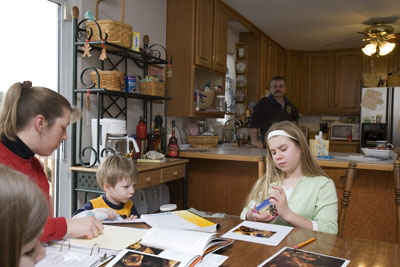
A typical scene in the Hunt household. Like some two million other US families, the parents are educating their children at home. They live in Littlestown, Pennsylvania. The mother, a 38-year-old former teacher, has designed the curriculum herself. The children are the class and the kitchen is their classroom. No other form of education is presently gaining popularity more rapidly in the US. The number of children taught at home is growing by 15 percent each year.
Because educational trends often target specific groups, there are many different reasons why people are opting for homeschooling. Liberal or conservative, families across the political spectrum are choosing this alternative. Religious parents want to teach their children about God. Many are dissatisfied with the quality of public schools. Mothers of gifted children or child prodigies also teach at home. Patti Hunt thinks that sex education should be taught by the parents. Above all, she wants her children to have the “best possible education,” she explains. She knows their needs better than any teacher.
Learning’s Easy if You’re Interested
On the wall are maps of Pennsylvania and the US, and a dozen photocopies of Rembrandt paintings. The rack is stacked with math and biology books. “My children learn more at home than they would in school,” says Hunt, her blond hair tied back in a braid. Instead of stubbornly following the public school curriculum, she teaches what her daughters want to know. “If you’re interested in a topic, you’ll learn about it,” she adds. Learning in school is often simply a matter of cramming for tests. “Once the test’s over, they forget what they learned.”
Studies have shown this to be true. Adult Americans who were homeschooled as children read more often, watch less television, and are more active in politics and the community than the average, reports Brian Ray, a sociologist from Oregon State University. They are more likely to go to college, and have no problem finding a job afterward, he says. They do 15 percent to 30 percent better on tests, regardless of their parents’ educational level. And they often have fewer social, psychological or emotional problems. For this reason, many American universities actively recruit students who have been homeschooled.
Now the father comes into the kitchen. Brian Hunt, 41, has just woken up. He drives fire trucks for the Baltimore fire department, and after being on duty for 24 hours, he gets three days off. In the afternoon he takes his daughters out in his own truck and makes deliveries. Both girls know how to drive the truck. In addition to their ABCs, homeschoolers often learn the professions of their parents as a sort of apprenticeship on the side, according to Hunt.
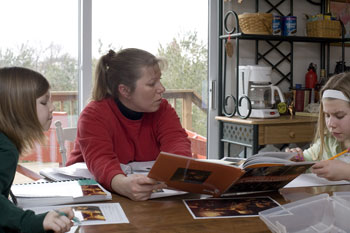
Critics maintain that homeschooled children are socially isolated. “I’m not worried about that,” says Hunt. Kayla, who wants to be a space scientist one day, has a black belt in karate. Lucy’s taking dance lessons. Every two weeks there’s a meeting of the homeschooling association of the town of Littlestown (pop. 4,000), attended by 70 families with 250 children. “We play with the children we like,” says Kayla, “not with those the school locks us up in a room with.” The mother views school as something artificial, and points out that nowhere else would only children of the same age be put together. But don’t kids learn from others their own age? “And learn what ?” answers the father. “About drugs, sex and violence? I want to protect my kids from all that.”
But there are also disadvantages to homeschooling. “We’re always broke,” he says. With only one income and three hungry kids, it’s hard to manage. But the advantages of what is supposedly a better education, he says, is compensation enough.
Jessica Decides What She Wants to Learn
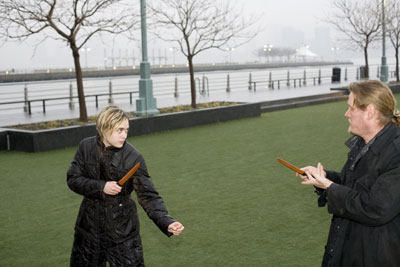
Martial arts are part of the New Yorker’s curriculum, and she trains daily for at least one hour. No teacher told her to do so. She herself decides what and when she wants to learn. “I only learn what interests me,” she explains as we sit in a café. She hasn’t been to school since third grade. “It was too loud, too crowded, and I wasn’t happy there. The teachers were completely preoccupied with trying to manage the chaos.” She wanted to go into things in depth, but the teachers just skimmed over the material.
Jessica and her twin sister Caroline were considered difficult children, and their parents took them out of school. “My daughters were independent children, but in class they always had to do everything in groups,” explains Penny Kjellberg, a 53-year-old entrepreneur. Her husband is a lawyer, and the family lives in Manhattan. She started out teaching the children at home on the basis of a curriculum she ordered online, but it did not work out well. “It was as if we were simply copying school.” Then the family came across a book entitled “Discover Your Child’s Learning Style.” The author, Victoria Hudson, argued that children learn best when they can decide for themselves what they want to learn and when. The Kjellbergs hired outside tutors for math, but left the rest up to the two girls, who were then aged 11.
Don’t Just Learn, Experience!
At the start of the school year, the mother sits down with her daughters and sketches out their learning goals. The children have to take it from there. “The less I say, the better they learn.” says Penny Kjellberg. “They do everything of their own free will.” And successfully too, as evidenced by the standardized tests that they always manage to pass with top marks. But freedom doesn’t tempt them to goof off. “My time is my life, and I’m not going to waste it,” says Jessica. “I enjoy what I do.”
Last summer, she heard about a falconer working with birds of prey in Central Park. She observed and fed the birds, and her interest grew. She went out into the countryside and spent a week in the forest. “Once I get interested in something, I don’t just read about it. I go experience it. I was a falconer myself.” Jessica takes singing lessons. Her martial arts teacher is a classically trained actor who compiles reading lists for her, and she attends natural science courses at the Museum for Natural History. If she wants to learn about the Big Bang, she visits the planetarium. “New York is full of knowledge, I can just suck it up.” She’s hardly ever at home; instead she roams the streets hungry for knowledge.
“Real life steels you for real life,” says Jessica. Her eloquence is impressive. Everything she says seems well-considered. “The ones who are successful in school are those who give the answers the teacher expects, but in real life you have to draw your own conclusions.” She doesn’t view her mother as a teacher. “She makes it possible for me to learn.” Especially as she trusts Jessica to make the right decisions. She doesn’t have many rules. She does have to call home often and be home on time, but otherwise she can do what she wants. “My parents know that I won’t abuse my freedom,” she says. “Why should I?” She stays away from drugs. “There’s a lot of pressure in school,” she says. “Trying to stay human makes a lot of people crazy. I don’t have any rules, so there are none for me to break.”
Homeroom With Three Desks
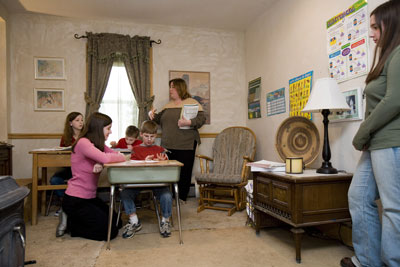
Here at home, Elizabeth Reale, 41, is educating five children. She explains the biology of frogs, and recounts the history of settlers in the 19th century. She hands an exercise book to Giuseppe, a lean 7-year-old. He carefully writes 4 + 2 = 6 on a blank page. “Sammy, if we divide two cakes among seven people, how many pieces does each person get ?” she asks her 9-year-old son, sitting in the second of the two rows. Sammy thinks about it. Right next to him, Nellie, age 11, tries to calculate the circumference of a circle. If a child has a question, the mother hastens over to help. Once a task has been finished, she continues. “We’re goal-oriented,” she says.
She’s opted for homeschooling “because I want to protect my children from the dangers of school.” Her oldest daughter Bridgette, now 18, attended kindergarten and first grade. Back then the number of school shootings was rapidly increasing. Reale took Bridgette out of school and taught her at home until she got her high school diploma. “Everybody says there are no weapons at their school, but that’s also what the parents whose children got shot had said.”
Early in the morning she drives her oldest daughter to work in the neighboring town. Then she gives the three youngest children arithmetic problems to solve, or has them read. She turns to Maggie, age 14, who wants to become a zoologist. Together they study Latin vocabulary. School rarely lasts more than three hours, which Reale says is sufficient to cover what needs to be learned. Since she works one-on-one with the children, she “deals with the material more efficiently than in a classroom with 30 children of different levels of ability.”
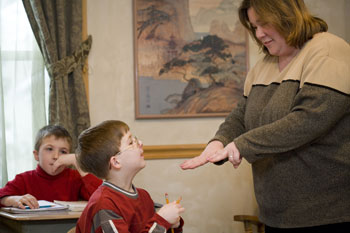
Following high school, Reale worked in a bar and then as a dental assistant. She had her first child at age 23. “Teaching came naturally to me,” she says. In the beginning, she bought lesson plans and textbooks. She sent homework in to be corrected “to make sure that the children were learning something.” Now she does everything herself. She has adapted the curriculum to what her children want to be when they grow up. For Maggie’s biology lessons, she once ordered a dead rat, which they dissected together. Since Bridgette wants to manage a bakery, she integrated accounting into her math lessons. There’s a scale model of the solar system on the kitchen wall; Giuseppe wants to be an astronomer and stroll along the rings of Saturn. Instead of running around after balls in a gym, they often go off to climb the nearest hill. “I’m not preparing my kids for college, I’m preparing them for life,” says Reale.
Each year she spends 200 dollars on books, pens and pencils, and exercise books – a drop in the bucket compared with the 30,000 dollars a year charged by private schools. Because the children don’t have to show up in new outfits at school every day, homeschooling is also cheaper than sending them to public school. “Sometimes we spend the whole day in pajamas,” says Reale, who describes herself as conservative. She preferred Ronald Reagan to Bill Clinton. For her, Hillary Clinton’s educational ideal of childcare for everyone is too left-wing. But she’s not in favor of getting rid of the public school system. “A lot of people would like to teach at home but can’t. You need a lot of dedication and patience, and you have to like children.”
Learning Without Age Barriers
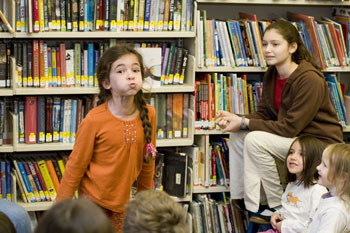
They slowly start to trickle in, five families in all, with a dozen children. The boys and girls sit together; the oldest is 14 and the youngest only five. These are children being homeschooled in Westchester County, an affluent, liberal New York suburb. In unison, they warm up their vocal chords; verses get lips and tongues moving.
Payne passes a book around and everyone has to read a few lines aloud. The older children manage somewhat better than the younger ones. If a little one says it wrong, an older one helps. “There are no age boundaries here,” says Lucy Albert, a cute 14-year-old with long brown hair and braces. “Boys and girls, children and teenagers all learn together.”
She is the oldest of four children; three girls and a boy. Her mother, Erynn Albert, is teaching Lucy, Mary (11), John (9) and Jane (6) at home – or rather on the go, as she puts it. In the mornings they learn math and writing, and in the afternoons their mother takes them in the minivan to Manhattan – for theater rehearsals, violin instruction, music lessons and to the museum. Three of them are in the children’s ensemble of the Lincoln Opera.
None of them has ever been to public school. Albert remembers how crazy their achievement-oriented friends in New York got when it was time to send the children to school. Their preschool age children had already passed exams to get into good schools. Parents were spending huge sums for private tutors to enable their children to pass these tests. “I wanted to spare my children and myself this stress,” explains Albert. She gave up her job as a special education teacher and started teaching her children at home. “That seemed more natural to me than sending them to school.”
She’s very grateful that her husband has made it possible for her to spend so much time with the children. He is an artist and has a fruit juice business. She would never send her children to school and go to work, says Albert, age 39. “I would miss them.” She describes herself as progressive and liberal, but she still wants to protect her children from the negative influence of popular culture. “We choose what we get into.” So she’s pleased that her children wear whatever they want, and not what a clique would expect of them. Lucy, who wants to be a director, is glad she doesn’t belong to a clique or have to keep up with trends. “We’re not thinking all the time about iPods, fashion or the newest cell phones,” says the 14-year-old. And she doesn’t know any schoolyard slang. “I speak English,” she adds.
Homeschoolers Win Academic Competition
At the start of the school year, Albert gives written notice to the school board that she will be teaching the children. She submits a lesson plan and sends in a report every three months. No one has told her how detailed this has to be. She can decide which subjects to teach, as long as they include math, languages, science and history. But nobody dictates how she has to go about it. So, for example, a trip to Gettysburg can count as a history project on Abraham Lincoln and the Civil War.
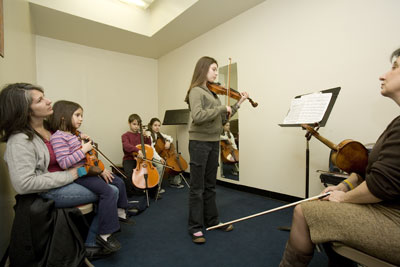
As a mother and teacher, she is deeply satisfied to see her children on the stage. Now it’s six thirty, and a long day of museum trips and music lessons is drawing to a close. In a high-ceilinged eggshell-colored room in the School for Strings in Manhattan, five children sit in a semicircle around their teacher. All have cellos clasped between their knees. “Who would like to play a solo?” asks the teacher. Mary Albert raises her bow up high. The 11-year-old performs Bach’s Minuet No. 3 with aplomb, and then bows politely. Her mother applauds.

I am completely fascinated by the story of the homeschooled 16year old twins. Great article, Peter!
We home educate too (here in the UK) and it is nice to hear how others approach it. We’re seeing a lot of problems over here in the mainstream schools and seeing increases in home education as parents are voting with their children’s feet.
Those on homeschooling should read this excellent article . I wish to suggest to all homeschooling parents this online English grammar help at http://www.autotick.com